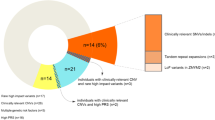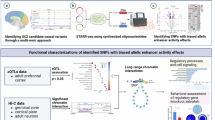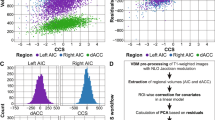Abstract
We previously reported linkage of schizophrenia and schizoaffective disorder to 13q32–34 in the European descent Afrikaner population from South Africa. The nature of genetic variation underlying linkage peaks in psychiatric disorders remains largely unknown and both rare and common variants may be contributing. Here, we examine the contribution of common variants located under the 13q32–34 linkage region. We used densely spaced SNPs to fine map the linkage peak region using both a discovery sample of 415 families and a meta-analysis incorporating two additional replication family samples. In a second phase of the study, we use one family-based data set with 237 families and independent case–control data sets for fine mapping of the common variant association signal using HapMap SNPs. We report a significant association with a genetic variant (rs9583277) within the gene encoding for the myosin heavy-chain Myr 8 (MYO16), which has been implicated in neuronal phosphoinositide 3-kinase signaling. Follow-up analysis of HapMap variation within MYO16 in a second set of Afrikaner families and additional case–control data sets of European descent highlighted a region across introns 2–6 as the most likely region to harbor common MYO16 risk variants. Expression analysis revealed a significant increase in the level of MYO16 expression in the brains of schizophrenia patients. Our results suggest that common variation within MYO16 may contribute to the genetic liability to schizophrenia.
Similar content being viewed by others
Log in or create a free account to read this content
Gain free access to this article, as well as selected content from this journal and more on nature.com
or
References
Abecasis GR, Burt RA, Hall D, Bochum S, Doheny KF, Lundy SL et al (2004). Genomewide scan in families with schizophrenia from the founder population of Afrikaners reveals evidence for linkage and uniparental disomy on chromosome 1. Am J Hum Genet 74: 403–417.
Ambacher KK, Pitzul KB, Karajgikar M, Hamilton A, Ferguson SS, Cregan SP (2012). The JNK- and AKT/GSK3beta-signaling pathways converge to regulate Puma induction and neuronal apoptosis induced by trophic factor deprivation. PLoS One 7: e46885.
Bowden DW, An SS, Palmer ND, Brown WM, Norris JM, Haffner SM et al (2010). Molecular basis of a linkage peak: exome sequencing and family-based analysis identify a rare genetic variant in the ADIPOQ gene in the IRAS Family Study. Hum Mol Genet 19: 4112–4120.
Cirulli ET, Goldstein DB (2010). Uncovering the roles of rare variants in common disease through whole-genome sequencing. Nat Rev Genet 11: 415–425.
Cruz E, Whittington C, Krikler SH, Mascarenhas C, Lacerda R, Vieira J et al (2008). A new 500 kb haplotype associated with high CD8+ T-lymphocyte numbers predicts a less severe expression of hereditary hemochromatosis. BMC Med Genet 9: 97.
Desmet FO, Hamroun D, Lalande M, Collod-Beroud G, Claustres M, Beroud C (2009). Human Splicing Finder: an online bioinformatics tool to predict splicing signals. Nucleic Acids Res 37: e67.
Di Rienzo A (2006). Population genetics models of common diseases. Curr Opin Genet Dev 16: 630–636.
Dickson SP, Wang K, Krantz I, Hakonarson H, Goldstein DB (2010). Rare variants create synthetic genome-wide associations. PLoS Biol 8: e1000294.
ISC (2008). Rare chromosomal deletions and duplications increase risk of schizophrenia. Nature 455: 237–241.
Joslyn G, Ravindranathan A, Brush G, Schuckit M, White RL (2010). Human variation in alcohol response is influenced by variation in neuronal signaling genes. Alcohol Clin Exp Res 34: 800–812.
Karayiorgou M, Torrington M, Abecasis GR, Pretorius H, Robertson B, Kaliski S et al (2004). Phenotypic characterization and genealogical tracing in an Afrikaner schizophrenia database. Am J Med Genet B 124B: 20–28.
Karst S, Cheng R, Schmitt AO, Yang H, de Villena FP, Palmer AA et al (2011). Genetic determinants for intramuscular fat content and water-holding capacity in mice selected for high muscle mass. Mamm Genome 22: 530–543.
Lee SH, DeCandia TR, Ripke S, Yang J, Sullivan PF, Goddard ME et al (2012). Estimating the proportion of variation in susceptibility to schizophrenia captured by common SNPs. Nat Genet 44: 247–250.
Li M, Boehnke M, Abecasis GR (2005). Joint modeling of linkage and association: identifying SNPs responsible for a linkage signal. Am J Hum Genet 76: 934–949.
Li M, Boehnke M, Abecasis GR (2006). Efficient study designs for test of genetic association using sibship data and unrelated cases and controls. Am J Hum Genet 78: 778–792.
Li Y, Willer CJ, Ding J, Scheet P, Abecasis GR (2010). MaCH: using sequence and genotype data to estimate haplotypes and unobserved genotypes. Genet Epidemiol 34: 816–834.
Lin S, Chakravarti A, Cutler DJ (2004). Exhaustive allelic transmission disequilibrium tests as a new approach to genome-wide association studies. Nat Genet 36: 1181–1188.
Lindquist S, Karitkina D, Langnaese K, Posevitz-Fejfar A, Schraven B, Xavier R et al (2011). Phosphoprotein associated with glycosphingolipid-enriched microdomains differentially modulates SRC kinase activity in brain maturation. PLoS One 6: e23978.
Manolio TA, Collins FS, Cox NJ, Goldstein DB, Hindorff LA, Hunter DJ et al (2009). Finding the missing heritability of complex diseases. Nature 461: 747–753.
Nakayama M, Kikuno R, Ohara O (2002). Protein-protein interactions between large proteins: two-hybrid screening using a functionally classified library composed of long cDNAs. Genome Res 12: 1773–1784.
O'Donovan MC, Craddock N, Norton N, Williams H, Peirce T, Moskvina V et al (2008). Identification of loci associated with schizophrenia by genome-wide association and follow-up. Nat Genet 40: 1053–1055.
Patel KG, Liu C, Cameron PL, Cameron RS (2001). Myr 8, a novel unconventional myosin expressed during brain development associates with the protein phosphatase catalytic subunits 1alpha and 1gamma1. J Neurosci 21: 7954–7968.
Purcell S, Neale B, Todd-Brown K, Thomas L, Ferreira MA, Bender D et al (2007). PLINK: a tool set for whole-genome association and population-based linkage analyses. Am J Hum Genet 81: 559–575.
Ripke S, O'Dushlaine C, Chambert K, Moran J, Kähler A, Akterin S et al (2011). Genome-wide association study identifies five new schizophrenia loci. Nat Genet 43: 969–976.
Rodriguez-Murillo L, Gogos JA, Karayiorgou M (2012). The genetic architecture of schizophrenia: new mutations and emerging paradigms. Annu Rev Med 63: 63–80.
Rose JE, Behm FM, Drgon T, Johnson C, Uhl GR (2010). Personalized smoking cessation: interactions between nicotine dose, dependence and quit-success genotype score. Mol Med 16: 247–253.
Sanna S, Li B, Mulas A, Sidore C, Kang HM, Jackson AU et al (2011). Fine mapping of five loci associated with low-density lipoprotein cholesterol detects variants that double the explained heritability. PLoS Genet 7: e1002198.
Shi J, Levinson DF, Duan J, Sanders AR, Zheng Y, Pe'er I et al (2009). Common variants on chromosome 6p22.1 are associated with schizophrenia. Nature 460: 753–757.
Shi Y, Li Z, Xu Q, Wang T, Li T, Shen J et al (2011). Common variants on 8p12 and 1q24.2 confer risk of schizophrenia. Nat Genet 43: 1224–1227.
Sobin C, Blundell ML, Conry A, Weiller F, Gavigan C, Haiman C et al (2001). Early, non-psychotic deviant behavior in schizophrenia: a possible endophenotypic marker for genetic studies. Psychiatry Res 101: 101–113.
Sobin C, Roos JL, Pretorius H, Lundy LS, Karayiorgou M (2003). A comparison study of early non-psychotic deviant behavior in Afrikaner and US patients with schizophrenia or schizoaffective disorder. Psychiatry Res 117: 113–125.
Stefansson H, Ophoff RA, Steinberg S, Andreassen OA, Cichon S, Rujescu D et al (2009). Common variants conferring risk of schizophrenia. Nature 460: 744–747.
Suarez BK, Duan J, Sanders AR, Hinrichs AL, Jin CH, Hou C et al (2006). Genomewide linkage scan of 409 European-ancestry and African American families with schizophrenia: suggestive evidence of linkage at 8p23.3-p21.2 and 11p13.1-q14.1 in the combined sample. Am J Hum Genet 78: 315–333.
Sudhof TC (2008). Neuroligins and neurexins link synaptic function to cognitive disease. Nature 455: 903–911.
Thompson RF, Langford GM (2002). Myosin superfamily evolutionary history. Anat Rec 268: 276–289.
Torrey EF, Webster M, Knable M, Johnston N, Yolken RH (2000). The stanley foundation brain collection and neuropathology consortium. Schizophr Res 44: 151–155.
Trynka G, Hunt KA, Bockett NA, Romanos J, Mistry V, Szperl A et al (2011). Dense genotyping identifies and localizes multiple common and rare variant association signals in celiac disease. Nat Genet 43: 1193–1201.
Waite K, Eickholt BJ (2010). The neurodevelopmental implications of PI3K signaling. Curr Top Microbiol Immunol 346: 245–265.
Walsh T, McClellan JM, McCarthy SE, Addington AM, Pierce SB, Cooper GM et al (2008). Rare structural variants disrupt multiple genes in neurodevelopmental pathways in schizophrenia. Science 320: 539–543.
Wang K, Zhang H, Ma D, Bucan M, Glessner JT, Abrahams BS et al (2009). Common genetic variants on 5p14.1 associate with autism spectrum disorders. Nature 459: 528–533.
Winchester CL, Ohzeki H, Vouyiouklis DA, Thompson R, Penninger JM, Yamagami K et al (2012). Converging evidence that sequence variations in the novel candidate gene MAP2K7 (MKK7) are functionally associated with schizophrenia. Hum Mol Genet 21: 4910–4921.
Xu B, Ionita-Laza I, Roos JL, Boone B, Woodrick S, Sun Y et al (2012). De novo gene mutations highlight patterns of genetic and neural complexity in schizophrenia. Nat Genet 44: 1365–1369.
Xu B, Roos JL, Dexheimer P, Boone B, Plummer B, Levy S et al (2011). Exome sequencing supports a de novo mutational paradigm for schizophrenia. Nat Genet 43: 864–868.
Xu B, Roos JL, Levy S, van Rensburg EJ, Gogos JA, Karayiorgou M (2008). Strong association of de novo copy number mutations with sporadic schizophrenia. Nat Genet 40: 880–885.
Xu B, Woodroffe A, Rodriguez-Murillo L, Roos JL, van Rensburg EJ, Abecasis GR et al (2009). Elucidating the genetic architecture of familial schizophrenia using rare copy number variant and linkage scans. Proc Natl Acad Sci USA 106: 16746–16751.
Yokoyama K, Tezuka T, Kotani M, Nakazawa T, Hoshina N, Shimoda Y et al (2011). NYAP: a phosphoprotein family that links PI3K to WAVE1 signalling in neurons. EMBO J 30: 4739–4754.
Zeggini E, Ioannidis JP (2009). Meta-analysis in genome-wide association studies. Pharmacogenomics 10: 191–201.
Acknowledgements
We thank all the families who participated in this research. For our Afrikaner cohorts, we thank H Pretorius and nursing sisters R van Wyk, C Botha, and H van den Berg for their assistance with subject recruitment, family history assessments, and diagnostic evaluations. We thank Yan Sun for technical assistance with all DNA sample preparations. We also thank the Center for Inherited Disease Research (CIDR), and in particular J Roberts and KF Doheny, for custom genotyping services under NIH Contract Number N01-HG-65403. We thank the Rutgers University Cell and DNA Repository for samples and also the Stanley Medical Research Institute for brain samples. The Rutgers samples were collected in three projects that participated in the NIMH Schizophrenia Genetics Initiative. From 1991 to 1997, the Principal Investigators and Co-Investigators were as follows—(i) Harvard University: MT Tsuang, S Faraone, and J Pepple; (ii) Washington University: CR Cloninger, T Reich, and D Svrakic; and (iii) Columbia University: C Kaufmann, D Malaspina, and JH Friedman.
For the GAIN and MGS_nonGAIN data sets, funding was provided through U01s MH79469 and MH79470. Assistance with data cleaning was provided by the National Center for Biotechnology Information. The GAIN and MGS data sets used for the analyses included in this manuscript were obtained from the database of dbGaP found at dbGaP (see URLs) through dbGaP accession numbers phs000021.v.2.p1 (GAIN) and phs000167.v.1.p1 (nonGAIN). Samples and associated phenotype data for the MGS GWAS study were collected under the following grants: NIMH Schizophrenia Genetics Initiative U01s: MH46276 (CR Cloninger), MH46289 (C Kaufmann), and MH46318 (MT Tsuang); and MGS Part 1 (MGS1) and Part 2 (MGS2) R01s: MH67257 (NG Buccola), MH59588 (BJ Mowry), MH59571 (PV Gejman), MH59565 (Robert Freedman), MH59587 (F Amin), MH60870 (WF Byerley), MH59566 (DW Black), MH59586 (JM Silverman), MH61675 (DF Levinson), and MH60879 (CR Cloninger). Further details of collection sites, individuals, and institutions may be found in Supplementary Table 1 of Sanders et al (2008; PMID: 18198266) and at the study dbGaP pages.
URLs:
dbGaP: http://www.ncbi.nlm.nih.gov/gap/
Plink: http://pngu.mgh.harvard.edu/~purcell/plink/
PedStats: http://www.sph.umich.edu/csg/abecasis/PedStats/
MACH: http://www.sph.umich.edu/csg/abecasis/MACH
LAMP: http://www.sph.umich.edu/csg/abecasis/LAMP
Metal: http://www.sph.umich.edu/csg/abecasis/Metal
UCSC genome browser: http://genome.ucsc.edu/
Stanley Medical Research Institute: http://stanleyresearch.org
Scan database: http://scandb.org
1000 genomes project: www.1000genomes.org, accession no.: ENST00000357550
Author information
Authors and Affiliations
Corresponding author
Additional information
Supplementary Information accompanies the paper on the Neuropsychopharmacology website
PowerPoint slides
Rights and permissions
About this article
Cite this article
Rodriguez-Murillo, L., Xu, B., Roos, J. et al. Fine Mapping on Chromosome 13q32–34 and Brain Expression Analysis Implicates MYO16 in Schizophrenia. Neuropsychopharmacol 39, 934–943 (2014). https://doi.org/10.1038/npp.2013.293
Received:
Revised:
Accepted:
Published:
Issue date:
DOI: https://doi.org/10.1038/npp.2013.293
Keywords
This article is cited by
-
Altered gene expression in antipsychotic-induced weight gain
npj Schizophrenia (2019)
-
Gene-body 5-hydroxymethylation is associated with gene expression changes in the prefrontal cortex of depressed individuals
Translational Psychiatry (2017)



